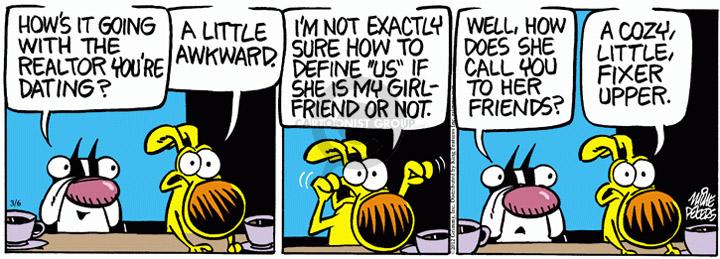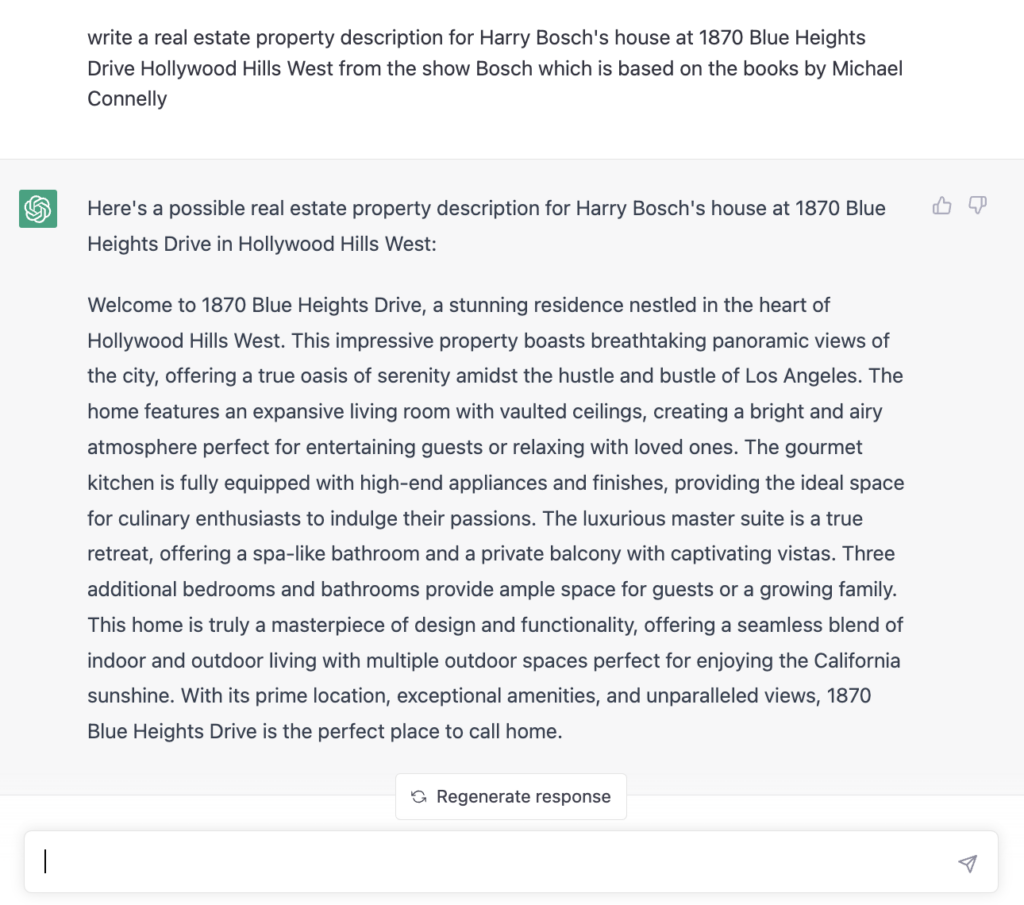Creative Real Estate Property Descriptions
UPDATE: Below we’re testing an artificial intelligence tool for writing property descriptions. It uses OpenAI’s ChatGPT to generate compelling and engaging descriptions that reflect the property details that you add below. So try adding an address with some basic info about the property. For example: 27 Almond Tree Lane in Irvine California is a 3 bed 2.5 bath single family residence.
It’s not perfect yet, but with our AI listing description generator, you can create high-quality and detailed property descriptions with minimal effort and add any tweaks before publishing.
Also read the rest of this article to learn WHY property descriptions are important for your marketing and some tips when creating them.
The California Association of Realtors (C.A.R.) estimates that more than half of buyers now find the property they eventually purchase via the internet. With so many properties available online, it creates a need for agents to ensure their listing catches the eye of prospective buyers and buyer’s agents.
“If you build it, they will come”
Ray Kinsella, played by Kevin Costner, in Field of Dreams

Unfortunately this famous quote from Field of Dreams, doesn’t apply to real estate. Not only that, but “If you list it, they will come” doesn’t work either.
The importance of creating eye-catching, high-quality real estate listing descriptions is more important than ever…yet somehow it’s still being overlooked based on many of the listings that buyers come across.
Here are the key points for writing amazing property descriptions:
Getting Creative with Listing Descriptions
Do’s and Dont’s when writing real estate descriptions
How AI can be used in real estate listing descriptions
Your Title is a Hook

Your real estate property listing’s title (or headline) is a primary factor in motivating your audience to click, tap, or take the next step towards being a legitimate prospect.
That’s because the title is used in the search results in most of the real estate search sites. Next to the property’s photo, the property’s title the most emphasized element that your listing gets on that search result page…so it should hook could-be home buyers. That’s 2X more important if you’re writing copy for real estate property ads.
The title is also the basis for the entire description of the home that people will see when they click through. If you’re trying to make the best real estate property listing, set the right tone by using the following tips in the property listing’s title:
- Use short titles: Although buyers have a strong tendency to initially notice your cover photo, a headline is also critical in providing context. One of the challenges in creating a headline is that it must be short while also descriptive enough to pique their interest. The heading should be concise and crafted to “cut to the point” using just a few words.
- Powerful language attracts attention: Those actively searching through dozens of property posts will often react to powerful words. High-impact verbiage can help to differentiate a listing. Some examples include words such as “amazing,” “stunning,” or “luxurious.” Try to revise your titles by finding a combination of words that are concise and powerful.
- Develop intriguing copy: The title of a listing should provide the prospective buyer with an incentive to continue reading further through the content. They should also trigger a positive emotional response. In addition to powerful and descriptive language, try using alliteration and cleverness to create more intrigue.
- Hint to key features: You don’t have a ton of space in the real estate listing title, which is always a challenge with real estate listing wording, but touching on a killer property feature can be a magnet for buyer interest. Especially if you know that this feature is one that is sought after in your target audience. For example, depending on the market, phrases like “stunning bay view, “lakefront”, “brand new”, “central” or “rooftop deck” can be game-changers for buyers. You know your market so make sure the features that are most in-demand (whether it’s location, amenity, etc) are mentioned.
- Avoid gimmicky tactics: This ain’t social media. There’s a certain level of professional decorum that’s expected in marketing your listing. So avoid using ALL CAPS or putting weird spacing or punctuation to draw attention. Titles call for um, title case. Use punctuation sparingly…and even if you are uncontrollably excited about this listing, resist the urge to use more than a single exclamation point.
Writing Creative Real Estate Listing Descriptions and Ads
Many of the best MLS listing descriptions lead with a narrative that tells a story and encourages consumers to use their imagination. One successful approach to writing real estate descriptions is explaining how a potential buyer’s life will be improved by this property.
For instance, you could describe a scene where the buyer is relaxing near the fireplace reading a good book with a clear view of the moonlit lake to excite the reader about the charming life they could lead in that home.

Imagery is a powerful technique for home descriptions that can grab readers…and it’s perfect for making creative real estate property descriptions that evoke wonderful emotions about a property’s surroundings or amenities.
More examples include, “the enjoyment of watching the sun slowly set in the western sky from the home’s back patio” or “take an evening stroll through your peaceful tree-lined neighborhood.”
If the reader makes it through this section, the goal of the property description changes. From here on out, explain the important details associated with the home. Any special or unique features that you considered including in the headline or title – and didn’t – should be referenced in this part of the real estate description. Mention these features prominently in the initial part of a paragraph for the best visibility.
Also unpack the feature(s) that you included in the title further down in the description. If they were important enough to potentially lead your audience to click through, then there’s a good chance they want to know more.
After this first portion, you can layer in all the other “table stakes” details people see in real estate descriptions — including room dimensions, descriptions, any recent renovations or improvements made, and features of the neighborhood. Remember that this factual part of the listing should contain new information without redundancy. For instance, if the headline or title mentions a luxurious three-bedroom condo, it is not necessary to discuss the number of bedrooms in the property further.
Use words throughout the description of the home that is expressive and tends to create an emotion or provoke thought. Examples may include “gourmet,” “professionally landscaped,” “vast,” or “just upgraded.” These terms should also be considered to accompany photos and further emphasize the image.
Google is a user-friendly tool for finding synonyms so you don’t play out your favorite descriptors. If everything is “amazing”, then nothing is “amazing”. Or at least we were told this by a Robin Williams-esque English teacher once upon a time.
Real Estate Descriptions Do’s and Don’ts
Do’s When Creating Property Listing Descriptions
Do select a high quality main property photo. Did we forget to mention that the photo is the first thing that catches home buyers attention when scrolling through a search result page packed with property listings? Well it is…and even the best real estate property description EVER won’t matter if your photos aren’t worthy of that initial click.
Do include as many visuals (photos, videos, and tours) as possible. Having too few visuals for a property may suggest that you’re hiding something. Seeing properties online is a lot like online dating. If your new online match is wearing a hat in every photo, it’s clear that they’re hiding something. Same goes for property photos that don’t show a key part of the home. Example: no interior photos. Don’t leave this kind of stuff to imagination because most savvy home-buyers and agents ain’t gonna assume the best. On a similar token, staging a home for taking photographs is a great idea EVEN if you adjust/reduce the amount of staging furniture later on. These rules apply to videos and 3D tours too. If you can, capture as many visuals as you can and use the ones that look the best (and remember the importance of lighting!).
Do use the features available in web listing platforms to your benefit. Did you know that Search Engine Optimization (SEO) doesn’t just apply to Google? Zillow, RedFin, and even the listings shown directly on the various MLS are search engines that can be optimized in to your benefit (or detriment). If you have information that can fit into a field on your listing, it’s in your best interest to add it because search engines use filters and having information available for these filters means your listing gets more exposure.
Do turn negative features into positive selling points. Every piece of real estate will have some flaw or imperfection. Rather than attempting to avoid mentioning a negative aspect of the property, it may be possible to convert or translate it into a positive. We’re not suggesting using any of the usual real estate jargon like “cozy” or “tons of potential” but here are a few examples:
- An undersized bedroom could be marketed as a flex space that could potentially be a great home office
- A property that lacks any significant yard space for grasses or a garden could be marketed as somewhat “maintenance free” with no need to worry about cutting the grass
- Basement or garden-level condo units that lack natural light and views offer savings on the costs of air conditioning
- A home in a busy, densely-populated area can be marketed as in the heart of it all or close to all the action
- The fully-carpeted first floor of the home also has beautiful hardwood floors hidden underneath
Do mention name brands when applicable. Perhaps the outdoor patio now has a built-in Bose wireless sound system installed? Or the kitchen was recently upgraded and furnished with Viking appliances that are Energy Star rated for efficiency. The new high-quality Anderson replacement windows were installed in the home last year.
Do check spelling, grammar, and punctuation. Research suggests that some buyers will bypass listings or advertisements where they recognize misspellings and other errors. It reflects poorly and raises questions about where else there could be carelessness . Consider some programs that are available for online corrections, such as Grammarly. Try reading your description aloud to gain a different perspective and to see if it sounds natural.
Do consider seeking assistance from professionals in creating a property listing. Ain’t no shame in delegating. Matter of fact it’s a smart time management tactic. So if you are struggling to find the right words OR just have more properties than you can feasibly dedicate time to, get a professional writer, photographer, or other real estate marketing guru to help. Yes, it costs money, but here’s why that shouldn’t matter: (a) time equals money (b) you can’t create any more time (c) but you can always shake your money maker more…so get shakin’
Don’ts When Creating Property Listing Descriptions
Don’t violate Fair Housing laws. When creating a description, you must avoid discriminatory language that refers to protected characteristics or classes. Always avoid any mention regarding race, gender, gender identity, religion, marital status, age, disability, immigration status, and others. Although unlikely to be seen as discriminatory, other phrases to avoid include “his and hers,” “bachelor pad,” or “retirees”.
Don’t hesitate to ask for opinions from others. Ask someone else’s opinion on the content of the listing description. Other real estate agents are an ideal audience for feedback. A fresh perspective can identify parts of the text that are confusing or complex. Encourage your critic to give you brutally honest feedback and even ask for suggestions to improve the content.
Don’t appear desperate to sell. We keep hitting on the importance of capturing prospective buyers’ attention with captivating listing property descriptions… but it is critical to avoid phrases that create a feeling of desperation. Examples may include “highly motivated seller,” “price reduced to sell ASAP,” or “no reasonable offers refused.” Evoking urgency is good, but not by sacrificing the perception of the property’s quality. This goes for real estate property ads just as much as the descriptions on the MLS listing descriptions and real estate search sites.
Don’t overly embellish or exaggerate. Although effective real estate listings are marketing pieces, a fine line exists between creating a positive image of the property and exaggeration. You may find that you receive more responses; however, those who view the property based on the embellished description may find that home does not meet their expectations. For example, stating that the home has a “recently renovated kitchen” when the remodel occurred 12 years ago is gonna just create more frustration down the line when the truth gets discovered. Ain’t nobody got time for that.
Don’t use notorious real estate marketing jargon. It’s a running gag in the industry. Using “cozy” in a description is only gonna work against you. Every other agent is gonna think you’re clueless…and most buyers know exactly how to translate that. “Cozy” = “Shoebox”.

If you have a listing, you should prioritize the quality of your descriptions in order to optimize online interest. Take the time to see how others are marketing their properties in real estate listings. Make sure you’re descriptions are evoking the intended emotions both from home-shoppers and buying agents. How do they make you feel when you put yourself in their shoes? Double-check for the do’s and don’ts we’ve listed. Familiarize yourself with new and emerging technology in today’s online environment. High-quality photos and virtual tours can be invaluable assets to any property listing. Recruit help when needed. Lastly, remember this is one of the more creative parts of the business so have some fun with this process.
How AI can be used in real estate listing descriptions
Why use an AI tool? Well these tools have gotten so good that they can write engaging real estate descriptions without ever stepping inside a home.
AI tools like ChatGPT can generate descriptions of properties based on certain input parameters. For example, an agent could input information about the property, such as the number of bedrooms, bathrooms, square footage, and location, and the AI tool could generate a descriptive paragraph about the property that the agent could use in their marketing materials.
AI tools can also help agents customize their descriptions based on the audience they are targeting. For example, if the agent is targeting families, the AI tool could suggest language that emphasizes the family-friendly features of the property, like a large backyard or a finished basement.
Here’s an example of a fictitious property description for Harry Bosch’s house from the book/TV series Bosch.

An AI may not nail the exact style you are after, but the property description it writes is a great starting point with the right paragraph length and structure, not to mention perfect spelling & grammar.
Plus AI tools can also help real estate agents improve their writing by suggesting better ways to phrase certain things. For example, if an agent writes “cozy” in their description, the AI tool could suggest alternative words like “intimate” or “inviting” that might be more effective.
Here’s a list of AI tools that real estate agents may want to check out:
Regardless if you get the bots to help with your property descriptions OR you do it the old fashioned way, real estate agents must think carefully about how they market their properties. A well-written description should highlight the unique features and benefits of a property, create an emotional connection with prospective buyers, and differentiate it from other properties on the market.
So even in the artificial intelligence age, copywriting skills are essential for real estate agents to add their style, branding, and local expertise to create compelling and effective property descriptions.
And these tips on writing real estate descriptions apply to all marketing strategies that attract potential buyers and ultimately lead to successful sales – see our real estate marketing guide for more tips.



